Abstract
African Americans experience a disproportionate burden of illness. According to the Centers for Disease Control and Prevention (CDC), heart disease, cancer, cerebrovascular disease and diabetes are the most common causes of mortality among African Americans. Data were gathered from 1,055 African-American women to gain their perspectives of the most serious health problems affecting African-American women and their related knowledge, attitudes and health promoting behaviors. Women listed CDC's top four causes of mortality as their top four most serious health threats. Cancer was reported as a serious health threat by 81% of the participants, whereas heart disease, the most common cause of mortality and a disease amenable to prevention and early intervention, was mentioned by only 31% of the women. Diabetes was reported by 59% of the women and cerebrovascular disease by 52%. As the Health Belief and other theoretical models would predict, awareness of the seriousness of these four disease groups among African-American women was associated with a greater likelihood of adherence for several of the recommended behaviors. Many opportunities exist for raising women's awareness of these four diseases and linking women's growing health awareness with those health promoting behaviors known to reduce morbidity and mortality.
Full text
PDF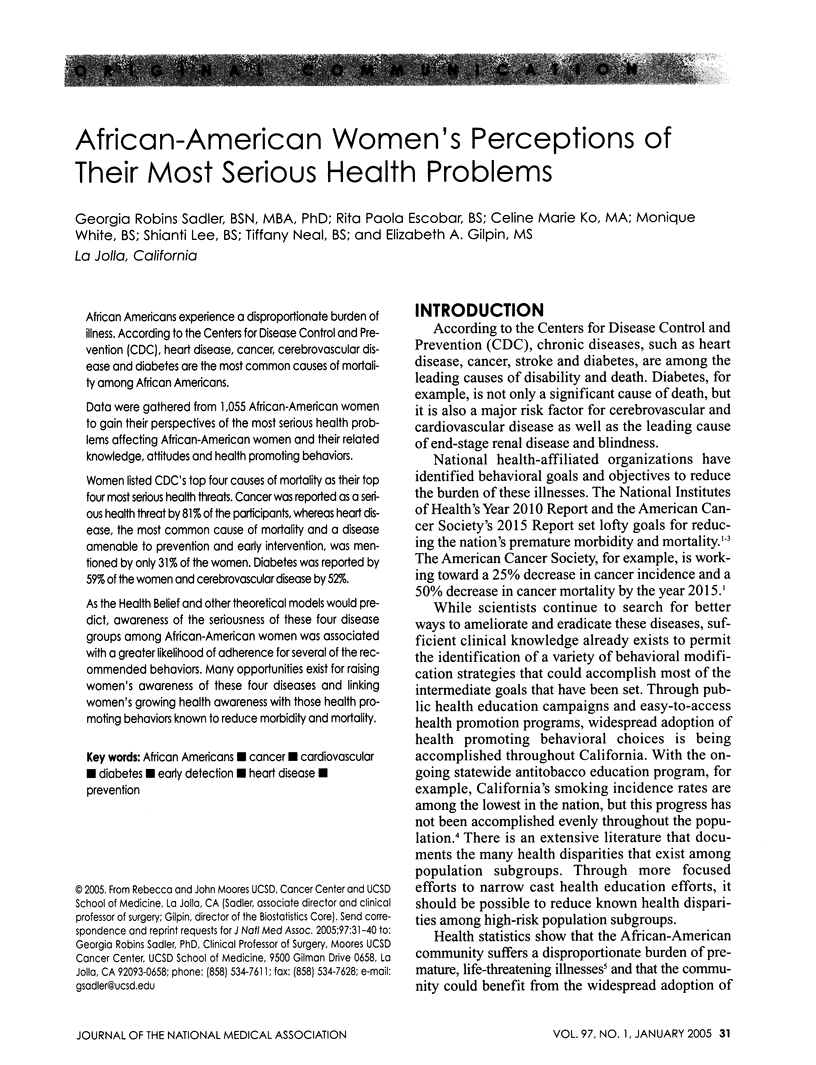
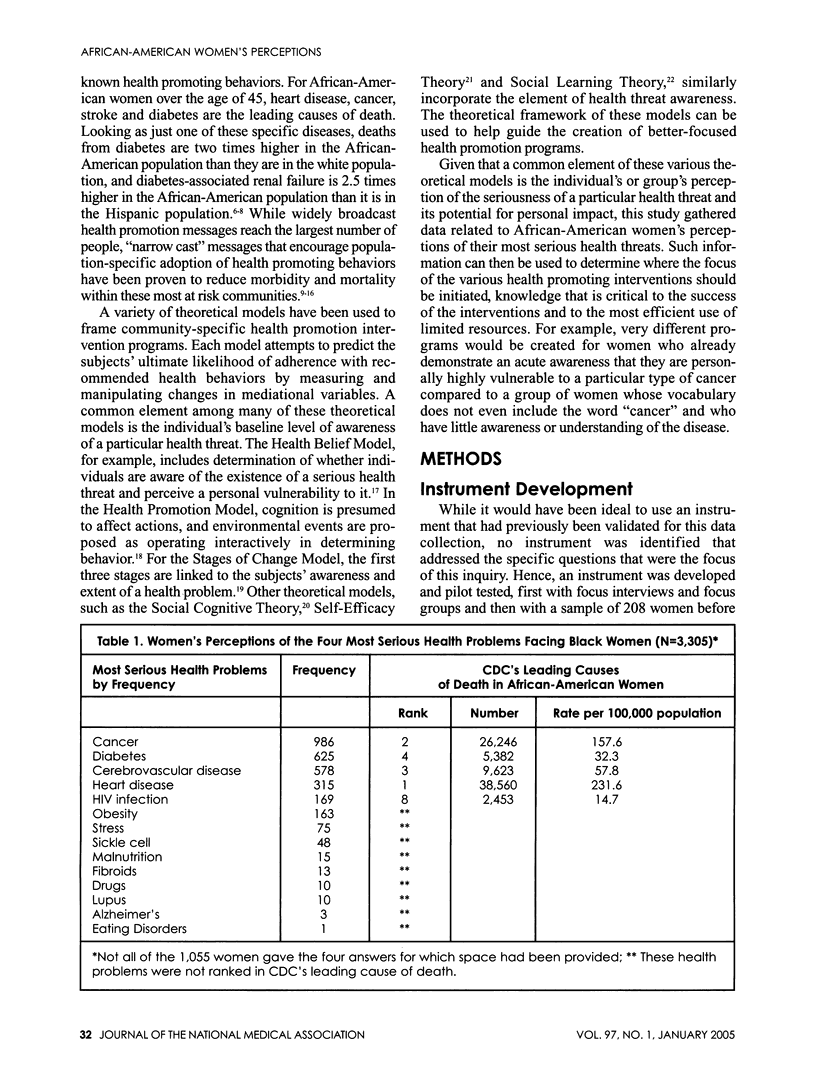
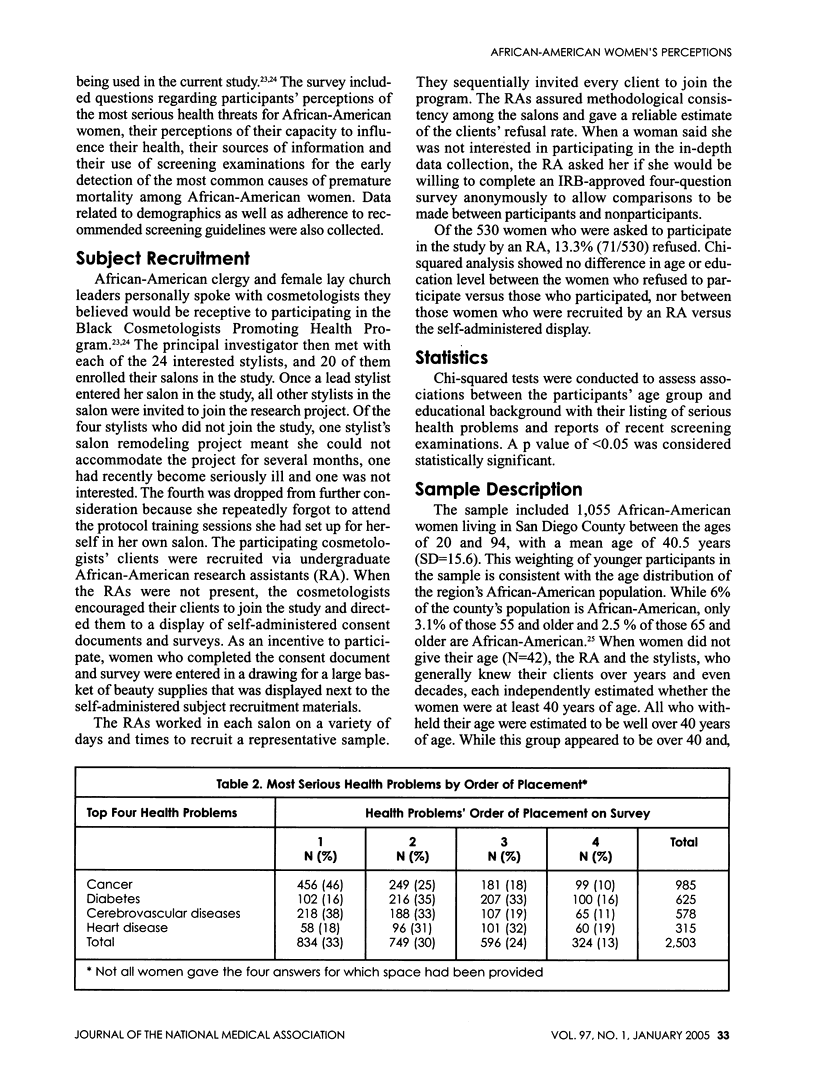
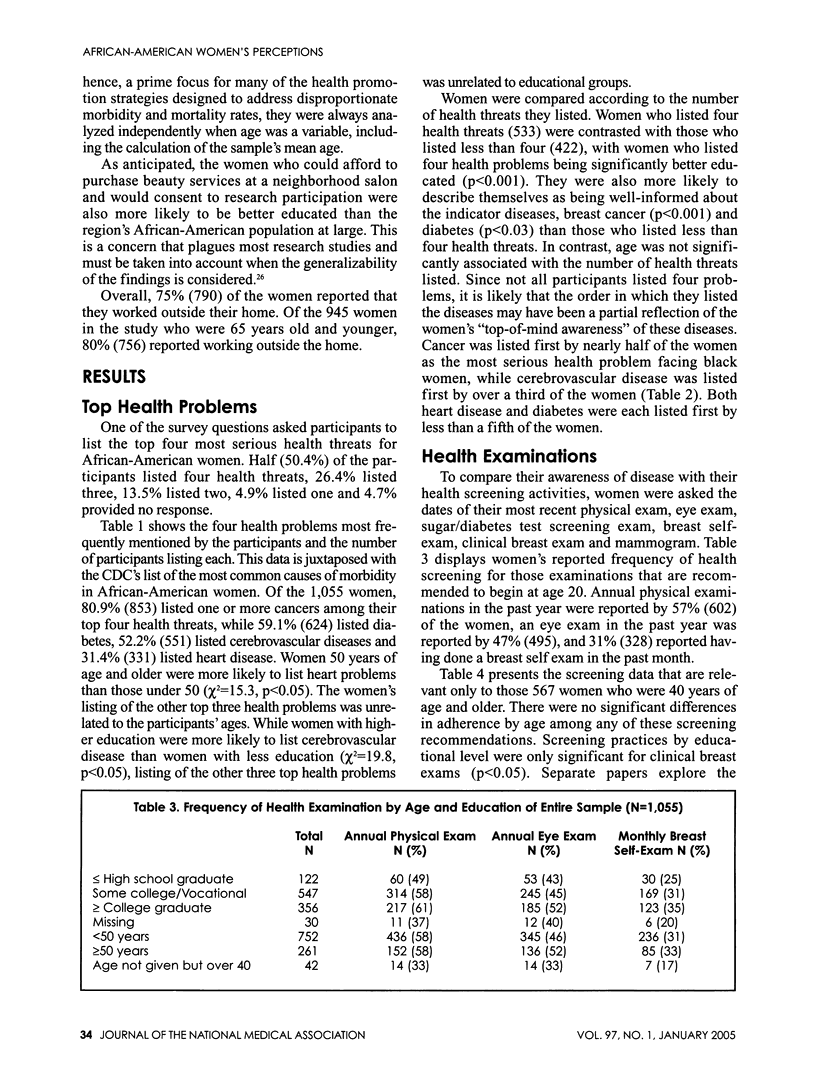
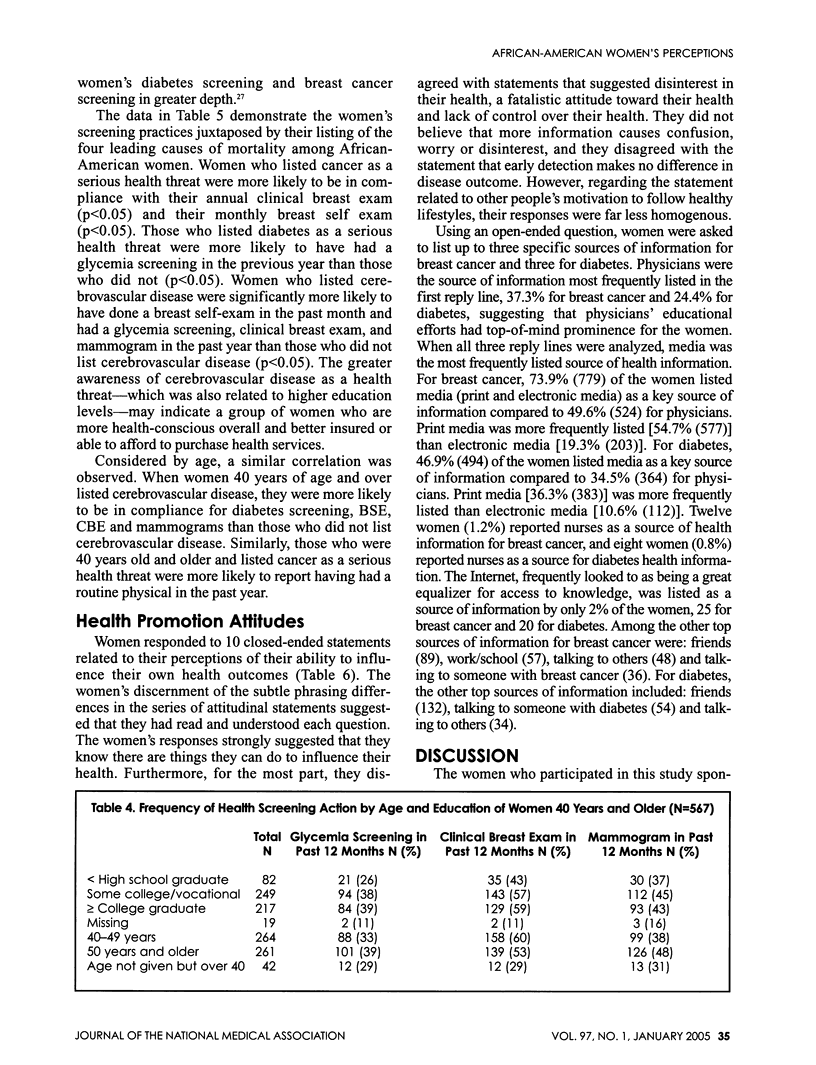
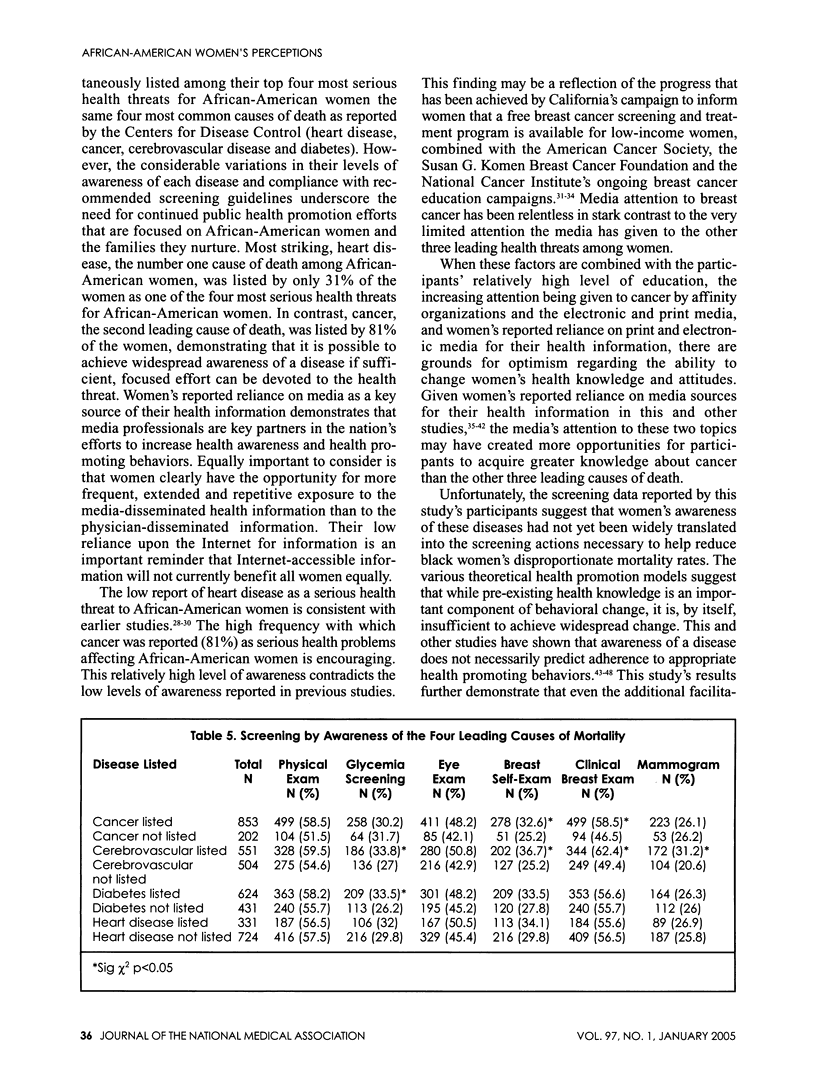
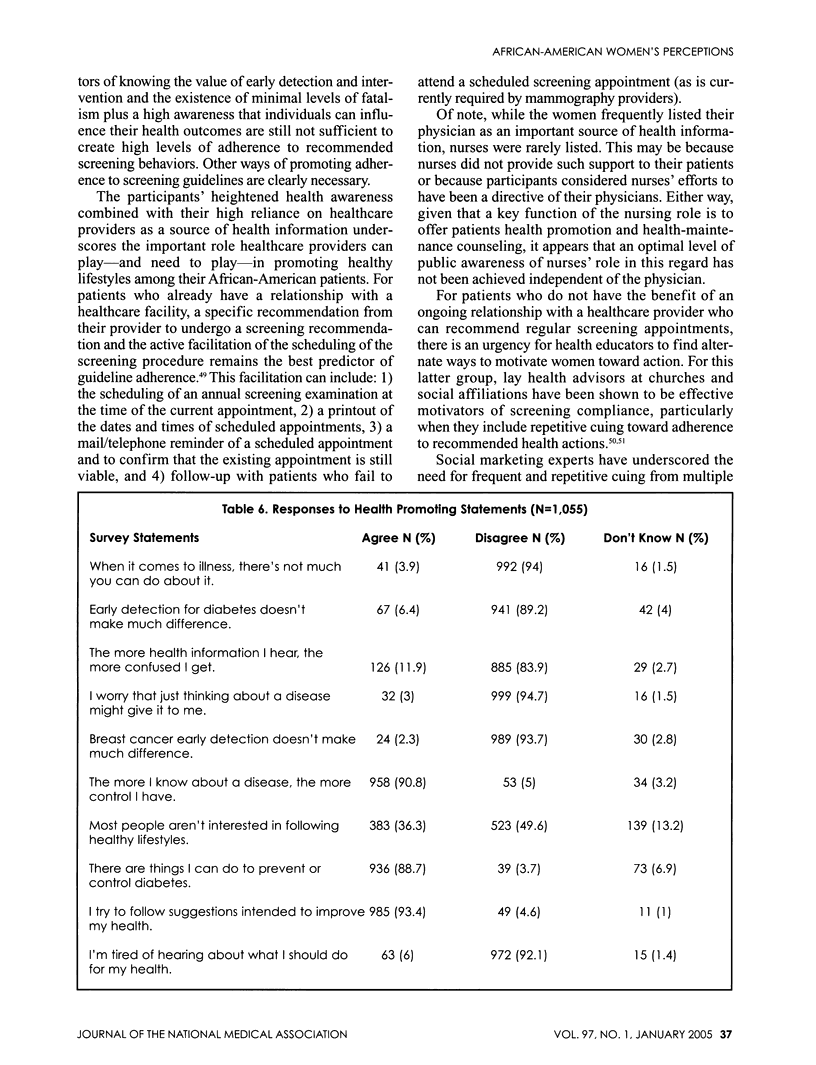



Selected References
These references are in PubMed. This may not be the complete list of references from this article.
- Bandura A. Self-efficacy: toward a unifying theory of behavioral change. Psychol Rev. 1977 Mar;84(2):191–215. doi: 10.1037//0033-295x.84.2.191. [DOI] [PubMed] [Google Scholar]
- Baquet C. R., Commiskey P. Socioeconomic factors and breast carcinoma in multicultural women. Cancer. 2000 Mar 1;88(5 Suppl):1256–1264. doi: 10.1002/(sici)1097-0142(20000301)88:5+<1256::aid-cncr13>3.0.co;2-3. [DOI] [PubMed] [Google Scholar]
- Barroso J., McMillan S., Casey L., Gibson W., Kaminski G., Meyer J. Comparison between African-American and white women in their beliefs about breast cancer and their health locus of control. Cancer Nurs. 2000 Aug;23(4):268–276. doi: 10.1097/00002820-200008000-00003. [DOI] [PubMed] [Google Scholar]
- Behera S. K., Winkleby M. A., Collins R. Low awareness of cardiovascular disease risk among low-income African-American women. Am J Health Promot. 2000 May-Jun;14(5):301-5, iii. doi: 10.4278/0890-1171-14.5.301. [DOI] [PubMed] [Google Scholar]
- Brancati F. L., Whelton P. K., Kuller L. H., Klag M. J. Diabetes mellitus, race, and socioeconomic status. A population-based study. Ann Epidemiol. 1996 Jan;6(1):67–73. doi: 10.1016/1047-2797(95)00095-x. [DOI] [PubMed] [Google Scholar]
- Clark C. M., Jr How should we respond to the worldwide diabetes epidemic? Diabetes Care. 1998 Apr;21(4):475–476. doi: 10.2337/diacare.21.4.475. [DOI] [PubMed] [Google Scholar]
- Dietz M. J., Simoes E. J., Waterman B., Jackson-Thompson J., Murayi T. Prevalence changes in modifiable cardiovascular disease risk factors in three Missouri regions, 1990-1996. Mo Med. 1998 Dec;95(12):654–662. [PubMed] [Google Scholar]
- Earp J. A., Viadro C. I., Vincus A. A., Altpeter M., Flax V., Mayne L., Eng E. Lay health advisors: a strategy for getting the word out about breast cancer. Health Educ Behav. 1997 Aug;24(4):432–451. doi: 10.1177/109019819702400404. [DOI] [PubMed] [Google Scholar]
- Gollop C. J. Health information-seeking behavior and older African American women. Bull Med Libr Assoc. 1997 Apr;85(2):141–146. [PMC free article] [PubMed] [Google Scholar]
- Harrell J. S., Gore S. V. Cardiovascular risk factors and socioeconomic status in African American and Caucasian women. Res Nurs Health. 1998 Aug;21(4):285–295. doi: 10.1002/(sici)1098-240x(199808)21:4<285::aid-nur2>3.0.co;2-b. [DOI] [PubMed] [Google Scholar]
- Hawley S. T., Earp J. A., O'Malley M., Ricketts T. C. The role of physician recommendation in women's mammography use: is it a 2-stage process? Med Care. 2000 Apr;38(4):392–403. doi: 10.1097/00005650-200004000-00006. [DOI] [PubMed] [Google Scholar]
- Hill D., Rassaby J., Gray N. Health education about breast cancer using television and doctor involvement. Prev Med. 1982 Jan;11(1):43–55. doi: 10.1016/0091-7435(82)90004-4. [DOI] [PubMed] [Google Scholar]
- Hoffman-Goetz L. Cancer experiences of African-American women as portrayed in popular mass magazines. Psychooncology. 1999 Jan-Feb;8(1):36–45. doi: 10.1002/(SICI)1099-1611(199901/02)8:1<36::AID-PON330>3.0.CO;2-8. [DOI] [PubMed] [Google Scholar]
- Jones D. W., Sempos C. T., Thom T. J., Harrington A. M., Taylor H. A., Jr, Fletcher B. W., Mehrotra B. D., Wyatt S. B., Davis C. E. Rising levels of cardiovascular mortality in Mississippi, 1979-1995. Am J Med Sci. 2000 Mar;319(3):131–137. doi: 10.1097/00000441-200003000-00001. [DOI] [PubMed] [Google Scholar]
- Kotler P., Zaltman G. Social marketing: an approach to planned social change. J Mark. 1971 Jul;35(3):3–12. [PubMed] [Google Scholar]
- Lau R., Kane R., Berry S., Ware J., Roy D. Channeling health: a review of the evaluation of televised health campaigns. Health Educ Q. 1980 Spring;7(1):56–89. doi: 10.1177/109019818000700105. [DOI] [PubMed] [Google Scholar]
- Leventhal H., Safer M. A., Cleary P. D., Gutmann M. Cardiovascular risk modification by community-based programs for life-style change: comments on the Stanford study. J Consult Clin Psychol. 1980 Apr;48(2):150–158. doi: 10.1037//0022-006x.48.2.150. [DOI] [PubMed] [Google Scholar]
- Lovato L. C., Hill K., Hertert S., Hunninghake D. B., Probstfield J. L. Recruitment for controlled clinical trials: literature summary and annotated bibliography. Control Clin Trials. 1997 Aug;18(4):328–352. doi: 10.1016/s0197-2456(96)00236-x. [DOI] [PubMed] [Google Scholar]
- McDonald P. A., Thorne D. D., Pearson J. C., Adams-Campbell L. L. Perceptions and knowledge of breast cancer among African-American women residing in public housing. Ethn Dis. 1999 Winter;9(1):81–93. [PubMed] [Google Scholar]
- Mitic W. R., Perkins J. The effect of a media campaign on heart attack delay and decision times. Can J Public Health. 1984 Nov-Dec;75(6):414–418. [PubMed] [Google Scholar]
- Mosca L., Jones W. K., King K. B., Ouyang P., Redberg R. F., Hill M. N. Awareness, perception, and knowledge of heart disease risk and prevention among women in the United States. American Heart Association Women's Heart Disease and Stroke Campaign Task Force. Arch Fam Med. 2000 Jun;9(6):506–515. doi: 10.1001/archfami.9.6.506. [DOI] [PubMed] [Google Scholar]
- Ni H., Nauman D., Burgess D., Wise K., Crispell K., Hershberger R. E. Factors influencing knowledge of and adherence to self-care among patients with heart failure. Arch Intern Med. 1999 Jul 26;159(14):1613–1619. doi: 10.1001/archinte.159.14.1613. [DOI] [PubMed] [Google Scholar]
- Pender N. J., Walker S. N., Sechrist K. R., Stromborg M. F. Development and testing of the Health Promotion Model. Cardiovasc Nurs. 1988 Nov-Dec;24(6):41–43. [PubMed] [Google Scholar]
- Phillips J. M., Cohen M. Z., Moses G. Breast cancer screening and African American women: fear, fatalism, and silence. Oncol Nurs Forum. 1999 Apr;26(3):561–571. [PubMed] [Google Scholar]
- Powe B. D. Fatalism among elderly African Americans. Effects on colorectal cancer screening. Cancer Nurs. 1995 Oct;18(5):385–392. [PubMed] [Google Scholar]
- Price J. H., Allensworth D. D. Utilizing mass media for health messages. Health Educ. 1979 Jul-Aug;10(4):17–19. [PubMed] [Google Scholar]
- Qureshi A. I., Giles W. H., Croft J. B. Racial differences in the incidence of intracerebral hemorrhage: effects of blood pressure and education. Neurology. 1999 May 12;52(8):1617–1621. doi: 10.1212/wnl.52.8.1617. [DOI] [PubMed] [Google Scholar]
- Rajaram S. S., Vinson V. African American women and diabetes: a sociocultural context. J Health Care Poor Underserved. 1998 Aug;9(3):236–247. doi: 10.1353/hpu.2010.0321. [DOI] [PubMed] [Google Scholar]
- Ritvo P., Irvine J., Robinson G., Brown L., Murphy K. J., Matthew A., Rosen B. Psychological adjustment to familial-genetic risk assessment for ovarian cancer: predictors of nonadherence to surveillance recommendations. Gynecol Oncol. 2002 Jan;84(1):72–80. doi: 10.1006/gyno.2001.6461. [DOI] [PubMed] [Google Scholar]
- Robbins J. M., Vaccarino V., Zhang H., Kasl S. V. Socioeconomic status and type 2 diabetes in African American and non-Hispanic white women and men: evidence from the Third National Health and Nutrition Examination Survey. Am J Public Health. 2001 Jan;91(1):76–83. doi: 10.2105/ajph.91.1.76. [DOI] [PMC free article] [PubMed] [Google Scholar]
- Sadler G. R., Thomas A. G., Gebrekristos B., Dhanjal S. K., Mugo J. Black cosmetologists promoting health program: pilot study outcomes. J Cancer Educ. 2000 Spring;15(1):33–37. doi: 10.1080/08858190009528650. [DOI] [PubMed] [Google Scholar]
- Sadler Georgia Robins, Meyer Margaret W., Ko Celine Marie, Butcher Crystal, Lee Shianti, Neal Tiffany, Reed Lynn, Veals Aaron E., Gilpin Elizabeth A. Black cosmetologists promote diabetes awareness and screening among African American women. Diabetes Educ. 2004 Jul-Aug;30(4):676–685. doi: 10.1177/014572170403000419. [DOI] [PubMed] [Google Scholar]
- Schoenberg N. E., Amey C. H., Coward R. T. Diabetes knowledge and sources of information among African American and white older women. Diabetes Educ. 1998 May-Jun;24(3):319–324. doi: 10.1177/014572179802400306. [DOI] [PubMed] [Google Scholar]
- Schoenfeld E. R., Greene J. M., Wu S. Y., Leske M. C. Patterns of adherence to diabetes vision care guidelines: baseline findings from the Diabetic Retinopathy Awareness Program. Ophthalmology. 2001 Mar;108(3):563–571. doi: 10.1016/s0161-6420(00)00600-x. [DOI] [PubMed] [Google Scholar]
- Shakoor-Abdullah B., Kotchen J. M., Walker W. E., Chelius T. H., Hoffmann R. G. Incorporating socio-economic and risk factor diversity into the development of an African-American community blood pressure control program. Ethn Dis. 1997 Autumn;7(3):175–183. [PubMed] [Google Scholar]
- Stover J. C., Skelly A. H., Holditch-Davis D., Dunn P. F. Perceptions of health and their relationship to symptoms in African American women with type 2 diabetes. Appl Nurs Res. 2001 May;14(2):72–80. doi: 10.1053/apnr.2001.22372. [DOI] [PubMed] [Google Scholar]
- Vanden Auweele Y. Lichaamsbeweging en sportbeoefening als gezondheidsbevorderend gedrag op middelbare leeftijd. Tijdschr Gerontol Geriatr. 1988 Dec;19(6):289–295. [PubMed] [Google Scholar]


